Mobile robots must learn to drive nicely among people
To spread the use of robots in production environments, the implementation must be as easy as start using a household plug-and-play product.
This is the target of the new research project “5G-ROBOT” lead by Aalborg University with professor Preben Mogensen at the helm.
The idea is that robots must learn to drive nicely in the production area if there are people within a certain range of the robot’s workspace. Vise versa they are allowed to speed up when there are no one in their vicinity, consequently increasing efficiency. Increasing efficiency must however never compromise safety, which is why it is paramount to be sure the area is “clear” before speeding up. To this end separate positioning systems will be part of the final system.
As the primary positioning system, the robots have LIDER and camera installed to determine if the path is clear. The challenge is that these systems need line-of-sight to be able to detect people. They will not be able to see a person standing close to their work area, but hidden behind e.g., a shelf. To this end radio waves come in handy as this technology can “see” behind corners. The vision is therefore that people in the production area must wear a radio tag for safety reasons.
However, if someone forget to bring a radio tag, or the tag is not properly read, there must be a second system taking over. This back-up system will be delivered by Ambolt AI and is based on Computer Vision technology.

